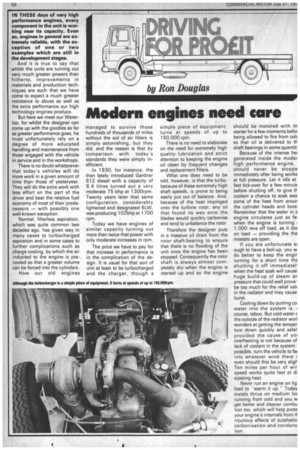Modern engines need care
Page 58

If you've noticed an error in this article please click here to report it so we can fix it.
IN THESE days of very high performance engines, every component in the unit is working near its capacity. Even so, engines in general are extremely reliable, with the exception of one or two examples which are still in the development stages.
And it is true to say that whilst the units are turning out very much greater powers than hitherto, improvements in materials and production techniques are such that we have come to expect a much greater resistance to abuse as well as the extra performance our high technology engines produce.
But here we meet our Waterloo, for whilst the designer can come up with the goodies as far as greater performance goes, he must unfortunately rely on a degree of more educated handling and maintenance from those engaged with the vehicle in service and in the workshops.
There is no doubt whatsoever that today's vehicles will do more work in a given amount of time than those of yesteryear. They will do the extra work with less effort on the part of the driver and beat the relative fuel economy of most of their predecessors — with possibly one well-known exception.
Normal, filterless aspiration, which was quite common two decades ago, has given way in many cases to turbocharged aspiration and in some cases to further complications such as charge cooling, by which the air inducted to the engine is pr.ecooled so that a greater volume can be forced into the cylinders.
How our old engines managed to survive those hundreds of thousands of miles without the aid of air filters is simply astonishing, but they did, and the reason is that by comparison with today's standards they were simply inefficient.
In 1930, for instance, the then lately introduced Gardner 612 diesel with a capacity of 8.4 litres turned out a very moderate 75 bhp at 1300rpm. Twenty years later that same configuration, considerably lightened and designated 6LW, was producing 102bhp at 1700 rpm.
Today we have engines of similar capacity turning out more than twice that power with only moderate increases in rpm.
The price we have to pay for that increase in performance is in the complication of the design. It is usual for that sort of unit at least to be turbocharged and the charger. though a simple piece of equipment, turns at speeds of up to 150,000 rpm.
There is no need to elaborate on the need for extremely high quality lubrication and strict attention to keeping the engine oil clean by frequent changes and replacement filters.
What one does need to be told, however, is that the turbo, because of these extremely high shaft speeds, is prone to being easily put out of balance. And, because of the heat impinged onto the turbine rotor, any oil that found its way onto the blades would quickly carbonise and tend to unbalance the rotor.
Therefore the designer puts in a massive oil drain from the rotor shaft-bearing to ensure that there is no flooding of the unit once the engine has been stopped. Consequently the rotor shaft is always almost completely dry when the engine is started up and so the engine
should be motored with th starter for a few moments befoi being allowed to fire from colt so that oil is delivered to th shaft bearings in some quantit,
Because of the intense he generated inside the moder high performance engine, should never be stoppe immediately after being workE at full pressure. Let it idle at fast tick-over for a few minutE before shutting off, to give th coolant a chance to soak awa some of the heat from arour the cylinder heads and bore Remember that the water in a engine circulates just as fa when the engine is turning 1,000 revs off load, as it dor on load — providing the the mostats are open.
If you are unfortunate ei ough to have a boil-up, you w do better to keep the engir turning for a short time tha shutting it off immediatel. when the heat soak will cause huge build-up of steam ar pressure that could well prove • be too much for the relief val\ in the radiator and may cause burst.
Cooling down by putting co water into the system is, course, taboo. But cold water the outside of the radiator worl wonders at getting the temper ture down quickly and safel provided the cause of yol overheating is not because of lack of coolant in the system. possible, turn the vehicle to far into whatever wind there i even should this be very sligF Ten miles per hour of wir speed works quite fast at di sipating heat.
Never run an engine on lig load to -warm it up.Today metals thrive on medium loE running from cold and you w get better and cleaner cornbu tion too, which will help prote your engine's internals from tl injurious effects of sulphatio carbonisation and condens tion.




































































































